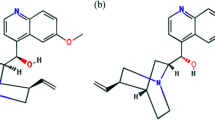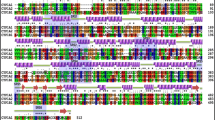Abstract
Among CYPs, CYP2A sub-family is well known for its function to metabolise xenobiotics. CYP2A includes three members: CYP2A6, CYP2A7 and CYP2A13. Of these three proteins, structure and function of CYP2A6 and CYP2A13 are widely studied, whereas very little study has been carried out on CYP2A7. In the initial in vitro studies on CYP2A7, full protein in its active form could not be expressed. The exact structure and function of CYP2A7 is still not revealed. However, up-regulation of CYP2A7 has been reported in malignant oesophageal cells and colon cancer cells. In the present study, we generated the structure of CYP2A7 protein. The modelled proteins were validated and subjected to molecular docking analyses. The energy and RMSD calculations demonstrated that the protein is highly conserved in nature, i.e., the protein is not much flexible. Here the ligand molecules of NCI Diversity Set II from the ZINC database against the active site of the CYP2A7 protein were screened. Five compounds that possess good inhibitory activity against CYP2A7 active site were identified. The top ranking molecule (ZINC01572309) has a minimum energy score of −12.0 kcal/Mol. This compound is thus a good starting point for further development of strong inhibitors. Our in silico approach could help in better structural and functional analysis of CYP2A7. Apart from structural description of CYP2A7, elaboration of binding sites for inhibitors provides us with an opportunity to utilise binding pockets in targeted inactivation of this protein for further research.










Similar content being viewed by others
References
Spatzenegger M, Jaeger W (1995) Clinical importance of hepatic cytochrome P450 in drug metabolism. Drug Metab Rev 27:397–417
Wrighton SA, VandenBranden M, Ring BJ (1996) The human drug metabolizing cytochromes P450. J Pharmacokinet Biopharm 24:461–473
Fernandez-Salguero P, Hoffman SM, Cholerton S, Mohrenweiser H, Raunio H, Rautio A, Pelkonen O, Huang JD, Evans WE, Idle JR, Gonzalez FJ (1995) A genetic polymorphism in coumarin 7-hydroxylation: sequence of the human CYP2A genes and identification of variant CYP2A6 alleles. Am J Hum Genet 57:651–660
Hoffman SM, Fernandez-Salguero P, Gonzalez FJ, Mohrenweiser HW (1995) Organization and evolution of the cytochrome P450 CYP2A–2B-2F subfamily gene cluster on human chromosome 19. J Mol Evol 41:894–900
Ding S, Lake BG, Friedberg T, Wolf CR (1995) Expression and alternative splicing of the cytochrome P-450 CYP2A7. Biochem J 306:161–166
Le Gal A, Dreano Y, Lucas D, Berthou F (2003) Diversity of selective environmental substrates for human cytochrome P450 2A6: alkoxyethers, nicotine, coumarin, N-nitrosodiethylamine, and N-nitrosobenzylmethylamine. Toxicol Lett 144:77–91
Yamano S, Tatsuno J, Gonzalez FJ (1990) The CYP2A3 gene product catalyzes coumarin 7-hydroxylation in human liver microsomes. Biochemistry 29:1322–1329
Stark K, Guengerich FP (2007) Characterization of orphan human cytochromes P450. Drug Metab Rev 39:627–637
Wagner G, Albano RM, Moraes EG et al (2002) CYP2A6/2A7 and CYP2E1 expression in human oesophageal mucosa: regional and inter-individual variation in expression and relevance to nitrosamine metabolism. Carcinogenesis 23:611–616
Lodhi SS, Farmer R, Singh AK, Wadhwa M, Jaiswal YK, Wadhwa G (2012) Statistical analysis of differential gene expression profile for colon cancer. Indian J Biotechnol 11:396–403
Sali A, Blundell TL (1993) Comparative protein modeling by satisfaction of spatial restraints. J Mol Biol 234:779–815
Eisenberg D, Luthy R, Bowie JU (1997) VERIFY3D: assessment of protein models with three-dimensional profiles. Methods Enzymol 277:396–404
Laskoswki RA, MacArthur MW, Moss DS, Thornton JM (1993) PROCHECK: a program to check the stereochemical quality of protein structures. J Appl Cryst 26:283–291
Singh BK, Nandini S, Dubey VK (2008) Modeled structure of trypanothione synthetase of Leishmania infantum for development of novel therapeutics for leishmaniasis. Curr Trend Biotechol Pharm 2:390–395
Singh BK, Nandini S, Jagannadham MV, Dubey VK (2008) Modeled structure of trypanothione reductase of Leishmania infantum. BMB Rep 41:444–447
Singh BK, Dubey VK (2009) In silico studies on tryparedoxin peroxidase of Leishmania infantum: structural aspects. Curr Pharm Biotechnol 10:626–630
DeLano WL (2002) The PyMOL molecular graphics system. Delano Scientific, Palo Alto
Hess B, Kutzner C, Spoel D, Lindahl E (2008) GROMACS 4: algorithms for highly efficient, load-balanced, and scalable molecular simulation. J Chem Theory Comput 4:435–447
Chris O, Alessandra V, Alan E, Wilfred FVG (2004) A biomolecular force field based on the free enthalpy of hydration and solvation: the GROMOS force-field parameter sets 53A5 and 53A6. J Comput Chem 25:1656–1676
Essmann U, Perera L, Berkowitz ML, Darden T, Lee H, Pedersen LG (1995) A smooth particle mesh ewald method. J Chem Phys 103:8577–8593
Hess B, Bekker H, Berendsen HJC, Fraaije JGEM (1997) LINCS: a linear constraint solver for molecular simulations. J Comput Chem 18:1463–1472
Berendsen HJC, Postma JPM, Gunsteren WF, DiNola A, Haak JR (1984) Molecular dynamics with coupling to an external bath. J Chem Phys 81:368–3690
Brady JPG, Stouten PFW (2000) Fast prediction and visualization of protein binding pockets with PASS. J Comput Aided Mol Des 14:383–401
Dundas J, Ouyang Z, Tseng J, Binkowski A, Turpaz Y, Liang J (2006) CASTp: computed atas of surface topography of proteins with structural and topographical mapping of functionally annotated residues. Nucl Acids Res 34:116–118
Irwin JJ, Shoichet BK (2005) ZINC-A free database of commercially available compounds for virtual screening. J Chem Inf Model 45:177–182
Trott O, Olson AJ (2010) AutoDock Vina: improving the speed and accuracy of docking with a new scoring function, efficient optimization and multithreading. J Comput Chem 31:455–461
Author information
Authors and Affiliations
Corresponding author
Rights and permissions
About this article
Cite this article
Lodhi, S.S., Farmer, R., Jaiswal, Y.K. et al. In Silico Structural, Virtual Screening and Docking Studies of Human Cytochrome P450 2A7 Protein. Interdiscip Sci Comput Life Sci 7, 129–135 (2015). https://doi.org/10.1007/s12539-015-0007-0
Received:
Revised:
Accepted:
Published:
Issue Date:
DOI: https://doi.org/10.1007/s12539-015-0007-0




